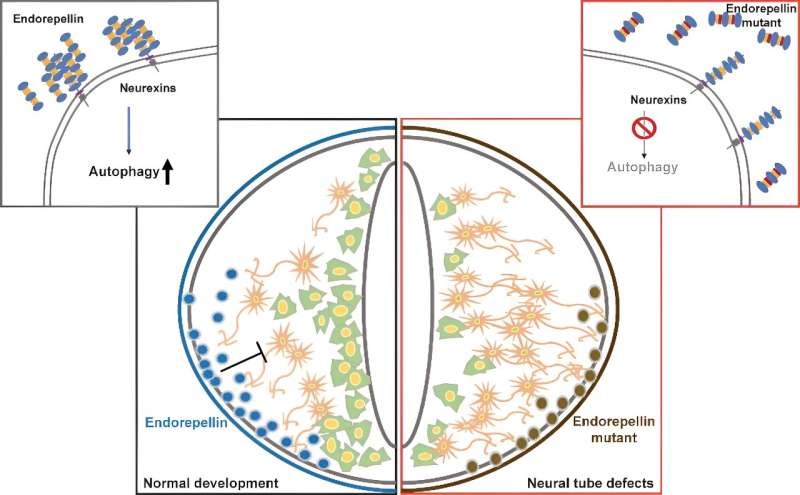This article has been reviewed according to Science X's editorial process and policies. Editors have highlighted the following attributes while ensuring the content's credibility:
fact-checked
trusted source
proofread
The interaction of endorepellin and neurexin triggers neuroepithelial autophagy and maintains neural tube development

Neural tube defects (NTDs) rank as the second most prevalent congenital malformation in humans, impacting the central nervous system development in approximately 1 in every 1,000 live births. Over 300 genes, including the HSPG2 gene, are implicated in NTDs in mice.
However, a considerable clinical hurdle remains in discerning pathogenic mutations for NTDs, especially given the proliferation of rare variants within NTD-associated genes identified through the advancement of DNA sequencing in sporadic human NTD cases.
In a study published in the journal Science Bulletin, Lu et al. identified 34 rare heterozygous HSPG2 mutations in 369 human NTDs, compared to 8 rare mutations detected in 200 controls.
Notably, Heparan sulfate proteoglycan 2 (HSPG2) emerges as the most significant among the 300 NTD-associated genes analyzed. HSPG2 encodes the matrix protein Perlecan, from which the secretory peptide endorepellin is cleaved, originating from domain V of Perlecan. However, the precise role of endorepellin in neural development remains unclear.
They proposed that when the KI mouse model carrying the query human HSPG2 mutations could recapitulate NTDs, it was reasonable to be attributed to pathogenic mutations. Employing sperm-like stem cells in a semi-cloning technique combined with CRISPR/Cas9, they swiftly generated 19 KI mouse lines within six months.
Despite the rare HSPG2 mutations identified in NTDs cases across the entire gene, phenotype analysis in KI mice revealed that pathogenic mutations were predominantly concentrated within domain V of Perlecan, namely the endorepellin.
More importantly, they demonstrated that endorepellin interacts with the membrane protein Neurexin in the neuroepithelial cells. This interaction is crucial for triggering a heightened level of autophagy, inhibiting neuronal stem cell differentiation, and facilitating normal neural tube development. They elucidated for the first time that the interaction of endorepellin and neurexin promopts neuroepithelial autophagy, crucial for maintaining neural tube development.
In conclusion, this study presents a paradigm for identifying the pathogenic mutations for complex genetic disorders such as NTDs. Generating mice with point mutations can be challenging, especially when biallelic mutations of the target gene would lead to sterility or lethality in mice.
Sperm-like stem cell-based semi-cloning technology effectively circumvents this obstacle, enabling rapid analysis of pathogenicity for numerous mutations. The in vivo interaction between the ligand protein endorepellin and the membrane protein receptor neurexin was successfully identified using double in situ tags which were also generated by semi-cloning technology.
The disruption of autophagy activation and the perturbed inhibition of neuronal differentiation caused by HSPG2 pathogenic mutations were found to be important determinants of NTD occurrence. The discovery that precocious differentiation of neuronal stem cells increases the risk of NTDs suggests that early differentiation inhibitors of neural stem cells could potentially serve as therapeutic agents to prevent NTDs resulting from deleterious HSPG2 mutations or disrupted endorepellin function.
This study was led by Prof. Hongyan Wang (Institute of Reproduction and Development, Obstetrics and Gynecology Hospital, Institute of Metabolism and Integrative Biology, Fudan University), Prof. Jinsong Li (Institute of Biochemistry and Cell Biology, Shanghai Institutes for Biological Sciences), Prof. Yunping Lei (Center for Precision Environmental Health, Baylor College of Medicine).
More information: Lei Lu et al, The interaction of endorepellin and neurexin triggers neuroepithelial autophagy and maintains neural tube development, Science Bulletin (2024). DOI: 10.1016/j.scib.2024.03.026



















